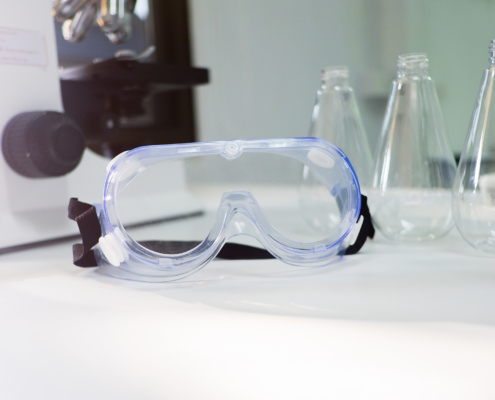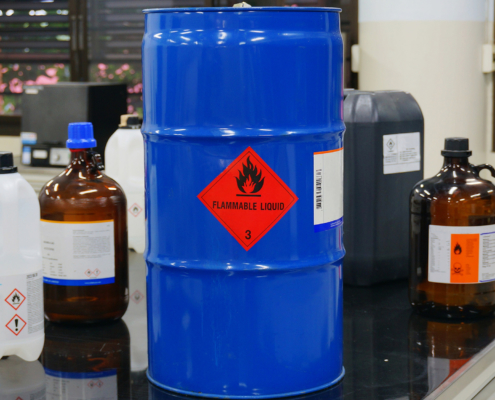
Understanding EPA Compliance Guidelines for Triple-Rinse Procedures
Businesses and operations that handle or clean empty chemical containers must comply with Environmental Protection Agency (EPA) guidelines to reduce the risk of contamination. One of the essential parts of EPA compliance is the triple-rinse procedure, which helps make sure chemical residue is flushed away before containers are recycled or disposed of.
In this article, we’ll discuss the triple-rinse procedure, EPA compliance guidelines for chemical containers, a walkthrough of how to clean chemical containers, the benefits of staying EPA compliant, and how companies like Axiom Products can help. Here’s what you need to know.
What Is the Triple-Rinse Procedure?
The triple-rinse procedure is a three-step process for cleaning empty chemical containers. It requires cleaning the container, filling it with fresh rinse water, and emptying it into a separate container. This process must be repeated three times to ensure that all hazardous residue has been removed from the container, reducing the risk of contamination to the environment or nearby businesses.
Triple-Rinse Procedure Approaches
Companies can take several approaches when performing a triple rinse on an empty chemical container. For example, some use automated systems or machines to do the job more quickly and efficiently than manual processes. Other methods include using detergents or special equipment designed specifically for this purpose. Regardless of the chosen approach, all necessary safety precautions must be taken before starting any job involving chemicals or hazardous materials.
The Chemical Jug Rinse System
The chemical jug rinse system is used in commercial and industrial settings to rinse and sanitize chemical jugs efficiently. This system typically includes a rinse tank, a pump, and a set of nozzles that spray water or sanitizer solution onto the jugs as they pass through the system. The chemical jug rinse system is important for maintaining sanitary conditions in facilities that use and handle chemicals, and preventing cross-contamination and the buildup of harmful residues on equipment.
Chemical Disposal Guidelines Regarding EPA Compliance
An empty chemical container is just as dangerous as a full one because of the residues left inside. That’s why the EPA passed the Resource Conservation and Recovery Act (RCRA) to protect communities and regulate the safe management of hazardous waste. The EPA defines an empty container in the following ways:
- All wastes have been removed using commonly employed practices
- No more than 2.5 centimeters of material remain in the container
- No more than 3% by weight of the container remains for containers with a capacity under 110 gallons
How Technology Aids EPA Compliance
Technology can be an effective tool for helping businesses stay compliant with EPA regulations when washing empty chemical containers.
- Automated systems are designed specifically for this purpose and can help speed up the process while maintaining proper protocols and standards set by the EPA.
- These systems allow businesses to track data related to their triple-rinse procedures, so they know precisely how they’re performing with compliance standards at all times.
- Automated systems also help reduce human error during the cleaning process, as all steps are done automatically without employees needing additional oversight or intervention.
How to Clean Chemical Containers
Cleaning chemical containers is an essential process that ensures the safety of individuals and the environment. Therefore, it’s important to understand the proper cleaning procedures for different types of containers. Outlined are a few processes below:
The Triple-Rinse Procedure for Empty Pesticide Containers
- Step 1: Protective gear is critical. Wear an apron, goggles, and long sleeves when rinsing empty chemical containers. Also, put on liquid-proof gloves and shoes to stop the absorption of chemicals through the skin.
- Step 2: Remove the container cap and empty the chemicals into the spray tank. Allow the container to drain for 30 seconds and rinse immediately to prevent the product from sticking.
- Step 3: Fill the container 20% full with water or rinse solution and replace the cap.
- Step 4: Swirl the liquid within the container to rinse all inside surfaces. Remove the cap, pour the remaining rinsate into the spray tank, and drain for 30 seconds. Steps 2 through 4 should be completed three times.
- Step 5: Puncture the container so it can’t be reused.
Triple Rinsing an Empty Chemical Drum Container
- Step 1: Empty the drum as much as possible and fill about 25% with water.
- Step 2: Tip the drum on its side and roll it back and forth for 30 seconds.
- Step 3: Stand the drum on one end and tip back and forth to rinse the inner edges. Turn the drum over and repeat.
- Step 4: Carefully empty the rinsate into the spray tank and repeat the first four steps two more times.
- Step 5: Carefully rinse the sprayer tank bung and dispose of it properly.
- Step 6: Puncture the base of the drum with a drill so it can’t be reused. Keep a drill bit stored specifically for this purpose.
Tired of having to triple-rinse containers by hand to meet EPA compliance guidelines for chemical disposal? Check out our products at Axiom today to streamline the process.
The Benefits of EPA Compliance
As a chemical professional, you understand the importance of following EPA compliance guidelines, but do you understand the benefits? Ensuring your business complies with EPA regulations regarding rinsing empty chemical containers can bring several financial and environmental advantages.
Avoiding Costly Penalties
Federal law requires that all chemical containers be rinsed before disposal. Adhering to EPA guidelines guarantees your business is protecting itself from costly penalties related to hazardous waste contamination. By following triple-rinse procedures for all empty chemical containers, you are taking an important step in preventing environmental contamination. This helps ensure your business does not have to pay for cleaning or repairs due to potentially hazardous waste spills.
Building a Positive Brand Reputation
Staying compliant with EPA regulations also helps your company build a positive reputation in the area. Following these guidelines demonstrates that your business cares about the environment and wants to help protect it from dangerous chemicals. This is a great way to attract customers who share similar values regarding safety and sustainability.
Saving Money
A drip-drained pesticide container still has as much as 3% of its contents. Triple-rinsing the container and adding the rinse water to the spray mix prevents the waste of valuable materials.
Axiom Products: Your Source for Efficient Triple-Rinse Products To Meet EPA Compliance
Triple-rinsing empty containers by hand is a tedious job. Luckily, Axiom’s Jet Rinse Triple-Rinsing Nozzle removes up to 99% of residue in under a minute, and its sharp point punctures metal and plastic containers. This increases the efficiency of your workplace and reduces costs. The nozzle connects to virtually any hose, allows users to empty containers at any time, and has various industrial applications.
Contact our team of experts today for quality equipment that will help you stay within EPA compliance guidelines regarding empty chemical containers.





